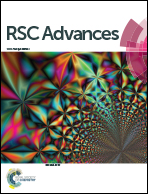CO2/water two-phase flow in a two-dimensional micromodel of heterogeneous pores and throats†
Abstract
Gas–liquid two-phase flow in porous media is highly relevant to numerous geological engineering processes. Pore network micromodeling is able to provide an effective way to experimentally observe the gas–liquid displacement phenomena. However, micromodel experiments were rarely conducted in heterogeneous conditions, which may significantly affect the displacement process. In this study, CO2/water displacement experiments were conducted at 25 °C and ambient pressure conditions in an etched glass micromodel with heterogeneous pores and throats. The experiments were performed in both vertical and horizontal directions with the CO2 injection rates ranging from 0.2 ml h−1 to 6.0 ml h−1. Dynamic displacements were detected in real time by a digital single lens reflex camera. Based on the experimental results, a detailed discussion about the instability of CO2 front and CO2 saturation variation was conducted. It is found that the displacements become more and more unstable with an advancing CO2 front. Small fingerings can be collapsed by capillary pressure. Micro-scale heterogeneity significantly influenced the flow pattern at both the microscale and macroscale. Moreover, we created a new evaluation parameter Seval to characterise CO2 saturation variations and the transformation of Seval agrees well with our experimental results of CO2 saturation.


 Please wait while we load your content...
Please wait while we load your content...